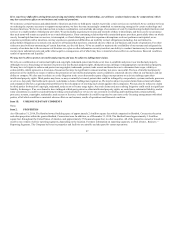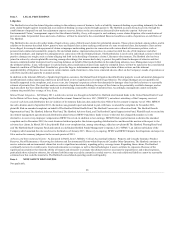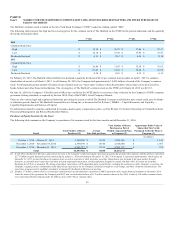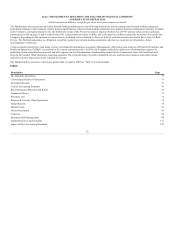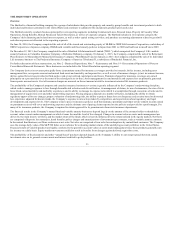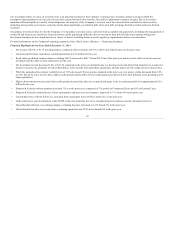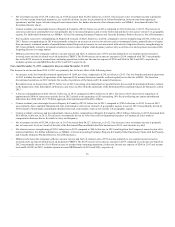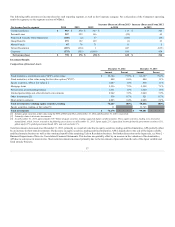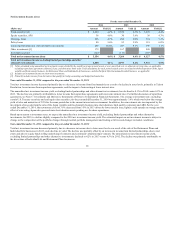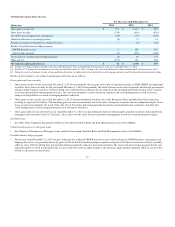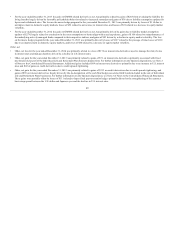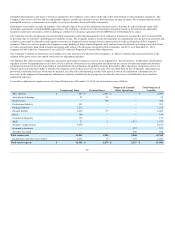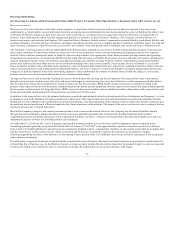The Hartford 2014 Annual Report Download - page 33
Download and view the complete annual report
Please find page 33 of the 2014 The Hartford annual report below. You can navigate through the pages in the report by either clicking on the pages listed below, or by using the keyword search tool below to find specific information within the annual report.
Overview
The Hartford is a financial holding company for a group of subsidiaries that provide property and casualty, group benefits and investment products to both
individual and business customers in the United States and continues to administer life and annuity products previously sold.
The Hartford currently conducts business principally in six reporting segments including Commercial Lines, Personal Lines, Property & Casualty Other
Operations, Group Benefits, Mutual Funds and Talcott Resolution, as well as a Corporate category. The Hartford includes in its Corporate category the
Company’s debt financing and related interest expense, as well as other capital raising activities; and purchase accounting adjustments related to goodwill
and other expenses not allocated to the reporting segments.
On June 30, 2014, the Company completed the sale of all of the issued and outstanding equity of HLIKK to ORIX Life Insurance Corporation, a subsidiary of
ORIX Corporation, a Japanese company. HLIKK sold variable and fixed annuity policies in Japan from 2001 to 2009 and had been in runoff since 2009.
On December 12, 2013, the Company completed the sale of Hartford Life International Limited ("HLIL"), which comprised the Company's U.K. variable
annuity business, to Columbia Insurance Company, a Berkshire Hathaway company. On January 1, 2013, the Company completed the sale of its Retirement
Plans business to Massachusetts Mutual Life Insurance Company ("MassMutual") and on January 2, 2013, the Company completed the sale of its Individual
Life insurance business to The Prudential Insurance Company of America ("Prudential"), a subsidiary of Prudential Financial, Inc.
For further discussion of these transactions, see Note 2 - Business Dispositions, Note 7 - Reinsurance and Note 19 - Discontinued Operations of Notes to
Consolidated Financial Statements. These businesses are included in the Talcott Resolution reporting segment.
The Company derives its revenues principally from: (a) premiums earned for insurance coverages provided to insureds; (b) fee income, including asset
management fees, on separate account and mutual fund assets and mortality and expense fees, as well as cost of insurance charges; (c) net investment income;
(d) fees earned for services provided to third parties; and (e) net realized capital gains and losses. Premiums charged for insurance coverages are earned
principally on a pro rata basis over the terms of the related policies in-force. Asset management fees and mortality and expense fees are primarily generated
from separate account assets. Cost of insurance charges are assessed on the net amount at risk for investment-oriented life insurance products.
The profitability of the Company's property and casualty insurance businesses over time is greatly influenced by the Company’s underwriting discipline,
which seeks to manage exposure to loss through favorable risk selection and diversification, its management of claims, its use of reinsurance, the size of its in
force block, actual mortality and morbidity experience, and its ability to manage its expense ratio which it accomplishes through economies of scale and its
management of acquisition costs and other underwriting expenses. Pricing adequacy depends on a number of factors, including the ability to obtain
regulatory approval for rate changes, proper evaluation of underwriting risks, the ability to project future loss cost frequency and severity based on historical
loss experience adjusted for known trends, the Company’s response to rate actions taken by competitors, and expectations about regulatory and legal
developments and expense levels. The Company seeks to price its insurance policies such that insurance premiums and future net investment income earned
on premiums received will cover underwriting expenses and the ultimate cost of paying claims reported on the policies and provide for a profit margin. For
many of its insurance products, the Company is required to obtain approval for its premium rates from state insurance departments.
The financial results in the Company’s mutual fund and variable annuity businesses depend largely on the amount of the contract holder or shareholder
account value or assets under management on which it earns fees and the level of fees charged. Changes in account value or assets under management are
driven by two main factors: net flows, and the market return of the funds, which is heavily influenced by the return realized in the equity markets. Net flows
are comprised of deposits less surrenders, death benefits, policy charges and annuitizations of investment type contracts, such as variable annuity contracts.
In the mutual fund business, net flows are known as net sales. Net sales are comprised of new sales less redemptions by mutual fund customers. The Company
uses the average daily value of the S&P 500 Index as an indicator for evaluating market returns of the underlying account portfolios in the United States.
Financial results of variable products are highly correlated to the growth in account values or assets under management since these products generally earn
fee income on a daily basis. Equity market movements could also result in benefits for or charges against deferred acquisition costs.
The profitability of fixed annuities and other “spread-based” products depends largely on the Company’s ability to earn target spreads between earned
investment rates on its general account assets and interest credited to policyholders.
33






